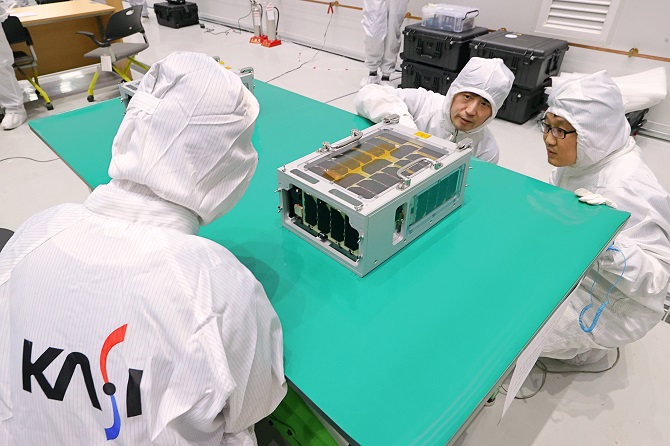
This undated photo provided by the Korea Aerospace Research Institute (KARI) shows the lower stages of South Korea’s first homegrown rocket Nuri at the Naro Space Center in Goheung, South Jeolla Province.
GOHEUNG, May 7 (Korea Bizwire) — Officials and researchers from South Korea’s state-run space institutions, universities and companies have begun last-minute preparations for a mission to put practical satellites into orbit for the first time.
South Korea’s homegrown space rocket Nuri is ready to be loaded with eight payloads and its lower stages have been completed for its scheduled launch on May 24 at the Naro Space Center in the country’s southern coastal village of Goheung.
Nuri, also known as KSLV-II, is the core part of South Korea’s 1.9 trillion-won (US$1.44 billion) project to launch 1.5-ton satellites into a low Earth orbit by its own space rocket between 2010-2023.
In 2021, Nuri successfully flew to its target altitude of 700 kilometers but failed to put a dummy satellite into orbit, as its third-stage engine burned out earlier than expected.
On its second attempt in 2022, Nuri successfully completed its flight sequence and deployed dummy satellites at the target altitude of 700 kilometers as planned.
The Korea Aerospace Research Institute (KARI), which has led South Korea’s state-run space projects, including Nuri, said unlike the previous two test launches, the upcoming take-off is given a different mission to launch practical satellites into orbit.
“This time, Nuri will carry eight payloads. It will make its debut as a rocket to put those satellites into orbit,” said Ko Jeong-hwan, who heads the Nuri project at KARI.
“It is the first time that Nuri is tasked with handling separate multiple satellites in one flight.”
The country’s second next-generation small satellite, the NEXTSAT-2, is the main payload on Nuri and will be loaded at the very top of the rocket’s head.
Designed and developed by the Korea Advanced Institute of Science and Technology (KAIST), the 180-kilogram NEXTSAT-2 will demonstrate X-band radar technology and measure space radiation on a dawn-dusk orbit for the next two years.
Four microsatellites developed by the Korea Astronomy and Space Science Institute, codenamed SNIPE, and located beneath the NEXTSAT-2, will identify temporal and spatial variations of small scale plasma structures in the ionosphere and magnetosphere.
Data from SNIPE will be shared with the U.S. National Aeronautics and Space Administration (NASA).

This undated photo provided by the Korea Aerospace Research Institute (KARI) shows officials inspecting a microsatellite developed by the Korea Astronomy and Space Science Institute, codenamed SNIPE, at the Naro Space Center in Goheung, South Jeolla Province.
The four SNIPE units were originally scheduled to be launched on a Russian rocket last year, but the plan was scrapped due to the ongoing Russia-Ukraine war.
The three others are the JAC by Korean engineering company Justek Inc., the LUMIR-T1 by local space firm Lumir Inc. and the KSAT3U by startup Kairospace Co.
As all eight payloads already arrived at the Naro Space Center last week and are being stored in a cleanroom, they have been rechecked to assure that they have not been damaged or affected in transit before mating with their rocket transport.
If the review is completed without problems, the craft will be attached to the final propulsive stage of the rocket within the payload fairing.
The payload fairing is the cone-shaped piece of equipment used to protect spacecraft payloads against dynamic pressure and heating during launch through the atmosphere.
When the rocket moves outside the atmosphere, the fairing is jettisoned to expose the payloads to outer space so they can be discharged.
The NEXTSAT-2, which will be released first from Nuri, will be located at the top position, and the seven microsatellites will be placed on either side of the main satellites underneath.
The upper stage then will be transported to a finally assembly building to be integrated with the lower stages that mainly house rocket engines and propellant.

The launch pad at the Naro Space Center in Goheung, South Jeolla Province, is seen here on May 3, 2023. (Yonhap)
“When Nuri takes off at 6:24 p.m., the lowest stage is separated after 125 seconds, and the fairing and the second stage are detached next one by one,” said Ko from KARI.
“The NEXTSAT-2 will be freed from the rocket 783 seconds after the launch, and the JAC comes next followed by the LUMIR-T1, the KSAT3U and the four SNIPE satellites at 20-second intervals.”
Once in place, many of the tests and verifications are repeated to assure workers that the payloads and its rocket interfaces are working together until the third week of May.
On the eve of the launch, the rocket is transported and erected on the launchpad and will go through verifications for electricity, fuel supply connection and other mechanical functions.
When all of these steps have been completed, a complete dress rehearsal of the final days of the countdown will be held and the liftoff will take place at 6:24 p.m. on May 24, while checks of the weather along the vehicle’s flight path are also conducted.
“As Nuri carries eight payload satellites, we are about to launch our rocket with our customers on board,” said KARI President Lee Sang-ryool.
“For the past decades, we’ve participated in space projects as a customer, but from now on, we will become a host of space launches.”
(Yonhap)






